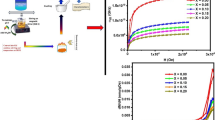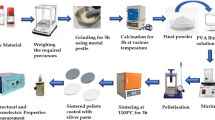Abstract
In the work, a fine powder of GdNb0.9Ta0.1O4-mixed gadolinium tantalum niobate activated with rare earth (REE) cations (Sm3+, Eu3+, Tb3+ and Er3+) was obtained by sol–gel synthesis. The evolution of the powder from amorphous to crystalline form was also studied in the work. The evolution was studied by synchronous thermal and X-ray analysis. The phase composition and structure of the resulting Gd0.96Eu0.01Sm0.01Tb0.01Er0.01Nb0.9Ta0.1O4 powders were analyzed in detail. Ceramic samples of the Gd0.96Eu0.01Sm0.01Tb0.01Er0.01Nb0.9Ta0.1O4 polycomponent solid solution were prepared from the sol–gel synthesized powder using traditional ceramic technology. The phase composition and characteristics of the structure of individual phases of the Gd0.96Eu0.01Sm0.01Tb0.01Er0.01Nb0.9Ta0.1O4 ceramic solid solution was determined by full-profile analysis of XRD patterns of polycrystals. We established that incorporation of REE (Tb, Er, Eu, Sm) into the gadolinium site in GdNb0.9Ta0.1O4 solid solution leads to various distortions of the corresponding polyhedra. Note that the distortion degree in this case is much greater than the distortion of the initial GdNbO4 structure. The photoluminescent (PL) properties of the Gd0.96Eu0.01Sm0.01Tb0.01Er0.01Nb0.9Ta0.1O4 solid solution were studied in the visible wavelength range. Analysis of literature and our own data revealed: electronic relaxation pathways in Gd0.96Eu0.01Sm0.01Tb0.01Er0.01Nb0.9Ta0.1O4 ceramics can be different depending on the energy of the exciting radiation. Excitation by the 376 nm line leads to internal energy conversion over 4fn–4fn levels of REE cations (Sm3+, Eu3+, Tb3+ and Er3+). The energy transfer between the Nb4+–O−–Ta4+–O− groups and REE is maximal in this case, while the radiation of the matrix from Nb4+–O−–Ta4+–O− emission centers is minimal. Upon excitation in the near-UV range (376 nm), Gd3+ cations do not participate in the energy transfer between the matrix and 4fn–4fn levels of REE dopants. The maximum PL of Gd0.96Eu0.01Sm0.01Tb0.01Er0.01Nb0.9Ta0.1O4 ceramics is observed in the green–red region of the spectrum from 5D0–7F2 and 4G5/2–6H7/2 transitions of Eu3+ and Sm3+. The emission is maximal at ~ 612 nm; it corresponds to the 5D0–7F2 electric dipole transition of the Eu3+ cation. We established that the efficiency of energy transfer between the matrix and doping REE cations for Gd0.96Eu0.01Sm0.01Tb0.01Er0.01Nb0.9Ta0.1O4 ceramics strongly depends on the energy of the exciting radiation.








Similar content being viewed by others
Data availability
The raw data required to reproduce these findings are available from the corresponding author on a reasonable request.
References
T. Yanagida, Inorganic scintillating materials and scintillation detectors. Proc. Jpn. Acad. Ser. B Phys. Biol. Sci. 94(2), 75–97 (2018). https://doi.org/10.2183/pjab.94.007
S. Ding, H. Zhang, Q. Zhang, Y. Chen, R. Dou, F. Peng, W.G. Liu, D. Sun, Experimental and first principle study of the structure, electronic, optical and luminescence properties of M-type GdNbO4 phosphor. J. Sol. St. Chem. 262, 87–83 (2018). https://doi.org/10.1016/j.jssc.2018.03.011
R. Haugsrud, B. Ballesteros, M. Lira-Cantú, T. Norby, Ionic and electronic conductivity of 5% Ca-doped GdNbO4. J. Electrochem. Soc. 153, J87–J90 (2006). https://doi.org/10.1149/1.2203933
F.E. Osterloh, Inorganic materials as catalysts for photochemical splitting of water. Chem. Mater. 20, 35–54 (2008). https://doi.org/10.1021/cm7024203
O. Voloshyna, I. Boiaryntseva, D. Spassky, O. Sidletskiy, Luminescence properties of the yttrium and gadolinium tantalo-niobates. Sol. St. Phen. 230, 172–177 (2015). https://doi.org/10.4028/www.scientific.net/SSP.230.172
O. Voloshyna, I. Gerasymov, O. Sidletskiy et al., Fast ultradense GdTa1-xNbxO4 scintillator crystals. Opt. Mater. 66, 332–337 (2017). https://doi.org/10.1016/j.optmat.2017.02.037
W.P. Liu, Q.L. Zhang, L.H. Ding, D.L. Sun, J.Q. Luo, S.T. Yin, Photoluminescence properties of LuTaO4:RE3+(RE3+= Eu3+, Tb3+) with M′-type structure. J. Alloys Compd. 474, 226–228 (2009). https://doi.org/10.1016/j.jallcom.2008.06.059
M. Yang, X. Liu, T. Hou, L. Du, Q. Wang, B. Chang, B. Li, J. Liu, G. Deng, Kityk Synthesis and luminescent properties of GdNbO4:Bi3+ phosphors via high temperature high pressure. J. Alloys Compd. 723, 1–8 (2017). https://doi.org/10.1016/j.jallcom.2017.06.204
M. Nikl, A. Yoshikawa, Recent R&D Trends in inorganic single-crystal scintillator materials for radiation detection. Adv. Opt. Mater. 3(4), 463–481 (2015). https://doi.org/10.1002/adom.201400571
A. Dwivedi, K. Mishra, S. Rai, Multi-modal luminescence properties of RE3+ (Tm3+, Yb3+) and Bi3+ activated GdNbO4 phosphors – upconversion, downshifting and quantum cutting for spectral conversion. J. Phys. D: Appl. Phys. 48, 435103 (2015). https://doi.org/10.1088/0022-3727/48/43/435103
K.P.F. Siqueira, P.P. Lima, R.A.S. Ferreira, L.D. Carlos, E.M. Bittar, F.M. Matinaga, R. Paniago, K. Krambrock, R.L. Moreira, A. Dias, Influence of the matrix on the red emission in europium self-activated orthoceramics. J. Phys. Chem. C 119(31), 17825–17835 (2015). https://doi.org/10.1021/acs.jpcc.5b05473
X. Liu, C. Chen, S. Li, Y. Dai, H. Guo, X. Tang, Y. Xie, L. Yan, Host-sensitized and tunable luminescence of GdNbO4: Ln3+ (Ln3+= Eu3+/Tb3+/Tm3+) nanocrystalline phosphors with abundant color. Inorg. Chem. 55, 10383–10396 (2016). https://doi.org/10.1021/acs.inorgchem.6b01637
N. da Silva Marques, E.J. Nassar, M. Verelst, R. Mauricot, H. Brunckova, L.A. Rocha, Effect of ytterbium amount on LaNbO4:Tm3+, Yb3+ nanoparticles for bio-labelling applications. Adv. Med. Sci. 65(2), 324–331 (2020). https://doi.org/10.1016/j.advms.2020.06.001
M. Ayvacikli, A. Ege, E. Ekdal, E.-J. Popovici, N. Can, Radioluminescence study of rare earth doped some yttrium based phosphors. Opt. Mater. 34(11), 1958–1961 (2012). https://doi.org/10.1016/j.optmat.2012.05.023
M.N. Palatnikov, M.V. Smirnov, S.M. Masloboeva, O.B. Shcherbina, N.V. Sidorov, N.I. Steblevskaya, M.V. Belobeletskaya, Luminescence properties of sol-gel derived ceramic GdNbxTa1-xO4 and YNbxTa1-xO4 solid solutions. Inorg. Mater. 56(4), 437–442 (2020). https://doi.org/10.1134/S0020168520040111
V.B. Zlokazov, V.V. Chernyshev, MRIA—a program for a full profile analysis of powder neutron-diffraction time-of-flight (Direct and Fourier) spectra. J. Appl. Cryst. 25, 447–451 (1992). https://doi.org/10.1107/S0021889891013122
R. Haugsrud, T. Norby, High-temperature proton conductivity in acceptor-substituted rare-earth ortho-tantalates, LnTaO4. J. Am. Ceram. Soc. 90(4), 1116–1121 (2007). https://doi.org/10.1111/j.1551-2916.2007.01621.x
R.B. Ferguson, The crystallography of synthetic YTaO4 and fused fergusonite. Can. Mineral. 6, 72–77 (1957)
V.S. Stubican, High-temperature transitions in rare-earth niobates and tantalates. J. Am. Ceram. Soc. 47, 55–58 (1964). https://doi.org/10.1111/j.1151-2916.1964.tb15654.x
S.A. Mather, P.K. Davies, Nonequilibrium phase formation in oxides prepared at low temperature: fergusonite-related phases. J. Am. Ceram. Soc. 78, 2737 (1995). https://doi.org/10.1111/J.1151-2916.1995.TB08049.X
L.N. Kinzhibalo, V.K. Trunov, A.A. Evdokimov, V.G. Krongauz, Refinement of the crystal structure of fergusonite. Sov. Phys. Crystallogr. 27, 22 (1982)
G. Blasse, A. Bril, Luminescence phenomena in compounds with fergusonite structure. J. Luminesc. 3, 109–131 (1970). https://doi.org/10.1016/0022-2313(70)90011-6
W. Liu, Q. Zhang, W. Zhou, C. Gu, S. Yin, Growth and luminescence of M-type GdTaO4 and Tb:GdTaO4 scintillation single crystals. IEEE Transact. Nucl. Sci. 57(3), 1287–1290 (2010). https://doi.org/10.1109/TNS.2009.2037320
X. Xiao, B. Yan, Synthesis and luminescent properties of novel RENbO4:Ln3+ (RE=Y, Gd, Lu; Ln=Eu, Tb) micro-crystalline phosphors. J. Non-Cryst. Sol. 351, 3634–3639 (2005). https://doi.org/10.1016/j.jnoncrysol.2005.09.018
J. Si, N. Yang, M. Xu, G. Li, G. Cai, W. Yi, J. Zhang, Structure and tunable luminescence in Sm3+/Er3+ doped host-sensitized LaNbO4 phosphor by energy transfer. Ceram. Internat. 46(18A), 28373–28381 (2020). https://doi.org/10.1016/j.ceramint.2020.07.341
P. Zhou, Q. Zhang, K. Ning, H. Yang, D. Sun, J. Luo, Sh. Yin, Structural and spectral investigations on heavily Er3+ doped RETaO4 (RE = Sc, Y, Gd, Lu) polycrystalline powders. Proc. SPIE. 8206, 820622 (2011). https://doi.org/10.1117/12.910449
M. Hirano, K. Ishikawa, Hydrothermal formation and up-conversion luminescence of Er3+-doped GdNbO4. J. Am. Ceram. Soc. 100(7), 2814–2821 (2017). https://doi.org/10.1111/jace.14835
D. Zhang, L. An Tang, ZZhu Yang, Potential red-emitting phosphor GdNbO4:Eu3+, Bi3+ for near-UV white light emitting diodes. Intern. J. Minerals Metallurg. Mater. 19(11), 1036–1039 (2012). https://doi.org/10.1007/s12613-012-0666-3
L. Zhang, Sh. Yi, X. Hu, B. Liang, W. Zhao, Y. Wang, Synthesis and photoluminescence properties of multicolor tunable GdNbO4: Tb3+, Eu3+ phosphors based on energy transfer. Modern Phys. Lett. B. 31(8), 1750051 (2017). https://doi.org/10.1142/S0217984917500518
L.H. Brixner, H.-Y. Chen, On the structural and luminescent properties of the M’ LnTaO4 rare earth tantalates. Chem. Etch. Charact. 130(12), 2435–2443 (1998). https://doi.org/10.1149/1.2119609
H. Zhang, Y. Wang, L. Xie, Luminescent properties of Tb3+ activated GdTaO4 with M and M’ type structure under UV–VUV excitation. J. Luminesc. 130, 2089–2092 (2010). https://doi.org/10.1016/j.jlumin.2010.05.032
O.B. Shcherbina, M.V. Smirnov, S.M. Masloboeva, K.P. Andryushin, V.V. Efremov, M.N. Palatnikov, Structure and properties of luminescent ceramics GdNbO4 obtained by usual technology and by hot pressing. Optik Intern. J. Light Electron. Opt. 245, 167683 (2021). https://doi.org/10.1016/j.ijleo.2021.167683
M. Nazarov, A. Zhbanov, Band edge singularities and density of states in YTaO4 and YNbO4. Moldav. J. Phys. Sci. 10(1), 52–58 (2011)
Funding
This work was financially supported by the Ministry of Science and Higher Education Russian Federation scientific topic 0186-2022-0002 (FMEZ-2022-0016).
Author information
Authors and Affiliations
Contributions
Conceptualization—O.B., M.N.; methodology—O.B., M.V., S.M., O.V.; validation—M.V., V.V., A.V.; investigation—O.B., M.V., S.M., O.V., E.V., Yu.P.; writing—original draft—O.B., M.V., S.M., E.V.; writing—review and editing—M.N.; visualization—O.B., M.V., V.V.; supervision—O.B., M.N.
Corresponding author
Ethics declarations
Conflict of interest
The authors declare that they have no conflict of interest.
Additional information
Publisher's Note
Springer Nature remains neutral with regard to jurisdictional claims in published maps and institutional affiliations.
Rights and permissions
Springer Nature or its licensor (e.g. a society or other partner) holds exclusive rights to this article under a publishing agreement with the author(s) or other rightsholder(s); author self-archiving of the accepted manuscript version of this article is solely governed by the terms of such publishing agreement and applicable law.
About this article
Cite this article
Palatnikov, M.N., Shcherbina, O.B., Masloboeva, S.M. et al. Sol–gel synthesis and structural and luminescent characteristics of a Gd0.96Eu0.01Sm0.01Tb0.01Er0.01Nb0.9Ta0.1O4 polycomponent solid solution. J. Korean Ceram. Soc. 60, 657–668 (2023). https://doi.org/10.1007/s43207-023-00288-3
Received:
Revised:
Accepted:
Published:
Issue Date:
DOI: https://doi.org/10.1007/s43207-023-00288-3




